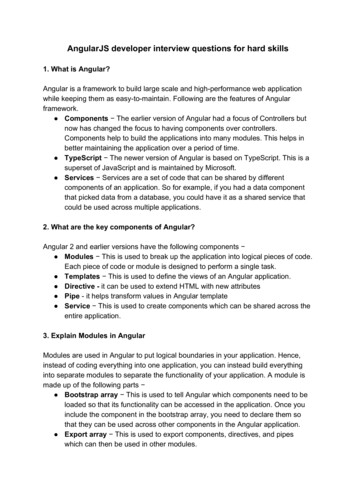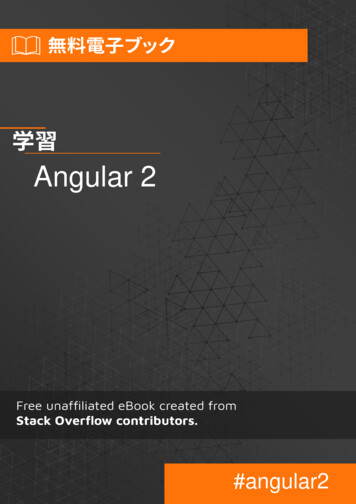
Transcription
Angular#angular
Table of ContentsAbout1Chapter 1: Getting started with Angular2Remarks2Versions3Examples5Installation of Angular using angular-cli6Prerequisites:6To setup a new project6To add to an existing project6Running The Project Locally6Generating Components, Directives, Pipes and Services7Angular "Hello World" ProgramPrerequisites:88Step 1: Creating a new project9Step 2: Serving the application10Step 3: Editing our first Angular component10Chapter 2: Event EmitterExamplesCatching the eventChapter 3: For LoopExamplesNgFor - Markup For LoopChapter 4: FormsExamplesReactive t.ts16app.component.html17validators.ts18
Template Driven Forms18Template - signup.component.html18Component - signup.component.ts19Model - signup-request.model.ts19App Module - app.module.ts20App Component - app.component.html20Chapter 5: Pipes21Introduction21Examples21Custom Pipes21Multiple custom pipes22Chapter 6: RoutingExamples2424Routing with children24Basic Routing25Chapter 7: RXJS and ObservablesExamples2828Wait for multiple requests28Basic Request28Chapter 8: Sharing data among ng data from parent component to child via shared service29Send data from parent component to child component via data binding using @Input30Sending data from child to parent via @Output event emitter31Sending data asynchronous from parent to child using Observable and Subject32Credits35
AboutYou can share this PDF with anyone you feel could benefit from it, downloaded the latest versionfrom: angularIt is an unofficial and free Angular ebook created for educational purposes. All the content isextracted from Stack Overflow Documentation, which is written by many hardworking individuals atStack Overflow. It is neither affiliated with Stack Overflow nor official Angular.The content is released under Creative Commons BY-SA, and the list of contributors to eachchapter are provided in the credits section at the end of this book. Images may be copyright oftheir respective owners unless otherwise specified. All trademarks and registered trademarks arethe property of their respective company owners.Use the content presented in this book at your own risk; it is not guaranteed to be correct noraccurate, please send your feedback and corrections to info@zzzprojects.comhttps://riptutorial.com/1
Chapter 1: Getting started with AngularRemarksAngular (commonly referred to as "Angular 2 " or "Angular 2") is a TypeScript-based opensource front-end web framework led by the Angular Team at Google and by a community ofindividuals and corporations to address all of the parts of the developer's workflow while buildingcomplex web applications. Angular is a complete rewrite from the same team that built AngularJS.¹The framework consists of several libraries, some of them core (@angular/core for example) andsome optional (@angular/animations).You write Angular applications by composing HTML templates with Angularized markup, writingcomponent classes to manage those templates, adding application logic in services, and boxingcomponents and services in modules.Then you launch the app by bootstrapping the root module. Angular takes over, presenting yourapplication content in a browser and responding to user interactions according to the instructionsyou've provided.Arguably, the most fundamental part of developing Angular applications are the components. Acomponent is the combination of an HTML template and a component class that controls a portionof the screen. Here is an example of a component that displays a simple string:src/app/app.component.tsimport { Component } from '@angular/core';@Component({selector: 'my-app',template: h1 Hello {{name}} /h1 })export class AppComponent {name 'Angular';}Every component begins with a @Component decorator function that takes a metadata object. Themetadata object describes how the HTML template and component class work together.The selector property tells Angular to display the component inside a custom my-app tag in theindex.html file.index.html (inside the body tag) my-app Loading AppComponent content here . /my-app The template property defines a message inside a h1 header. The message starts with "Hello"https://riptutorial.com/2
and ends with {{name}}, which is an Angular interpolation binding expression. At runtime, Angularreplaces {{name}} with the value of the component's name property. Interpolation binding is one ofmany Angular features you'll discover in this documentation. In the example, change thecomponent class's name property from 'Angular' to 'World' and see what happens.This example is written in TypeScript, a superset of JavaScript. Angular uses TypeScript becauseits types make it easy to support developer productivity with tooling. Additionally, almost allsupport is for TypeScript and so using plain JavaScript to write your application will be difficult. Writing Angular code in JavaScript is possible, however; this guide explains how.More information on the architecture of Angular can be found hereVersionsVersionRelease Date5.0.0-beta.1 com/3
VersionRelease 2.3.12016-12-15https://riptutorial.com/4
VersionRelease 5-02Exampleshttps://riptutorial.com/5
Installation of Angular using angular-cliThis example is a quick setup of Angular and how to generate a quick example project.Prerequisites: Node.js 6.9.0 or greater. npm v3 or greater or yarn. Typings v1 or greater.Open a terminal and run the commands one by one:npm install -g typingsor yarnnpm install -g @angular/cliglobal add typingsor yarnglobal add @angular/cliThe first command installs the typings library globally (and adds the typings executable to PATH).The second installs @angular/cli globally, adding the executable ng to PATH.To setup a new projectNavigate with the terminal to a folder where you want to set up the new project.Run the commands:ng new PROJECT NAMEcd PROJECT NAMEng serveThat is it, you now have a simple example project made with Angular. You can now navigate to thelink displayed in terminal and see what it is running.To add to an existing projectNavigate to the root of your current project.Run the command:ng initThis will add the necessary scaffolding to your project. The files will be created in the currentdirectory so be sure to run this in an empty directory.Running The Project Locallyhttps://riptutorial.com/6
In order to see and interact with your application while it's running in the browser you must start alocal development server hosting the files for your project.ng serveIf the server started successfully it should display an address at which the server is running.Usually is this:http://localhost:4200Out of the box this local development server is hooked up with Hot Module Reloading, so anychanges to the html, typescript, or css, will trigger the browser to be automatically reloaded (butcan be disabled if desired).Generating Components, Directives, Pipesand ServicesThe ng generate scaffold-type name (or simply ngyou to automatically generate Angular components:g scaffold-type name )command allows# The command below will generate a component in the folder you are currently atng generate component my-generated-component# Using the alias (same outcome as above)ng g component my-generated-component# You can add --flat if you don't want to create new folder for a componentng g component my-generated-component --flat# You can add --spec false if you don't want a test file to be generated (my-generatedcomponent.spec.ts)ng g component my-generated-component --spec falseThere are several possible types of scaffolds angular-cli can generate:Scaffold TypeUsageModuleng g module my-new-moduleComponentng g component my-new-componentDirectiveng g directive my-new-directivePipeng g pipe my-new-pipeServiceng g service my-new-serviceClassng g class my-new-classInterfaceng g interface my-new-interfacehttps://riptutorial.com/7
Scaffold TypeUsageEnumng g enum my-new-enumYou can also replace the type name by its first letter. For example:ng g m my-new-moduleto generate a new module or ngg c my-new-componentto create a component.Building/BundlingWhen you are all finished building your Angular web app and you would like to install it on a webserver like Apache Tomcat, all you need to do is run the build command either with or without theproduction flag set. Production will minifiy the code and optimize for a production setting.ng buildorng build --prodThen look in the projects root directory for a /dist folder, which contains the build.If you'd like the benefits of a smaller production bundle, you can also use Ahead-of-Time templatecompilation, which removes the template compiler from the final build:ng build --prod --aotUnit TestingAngular provides in-built unit testing, and every item created by angular-cli generates a basic unittest, that can be expended. The unit tests are written using jasmine, and executed through Karma.In order to start testing execute the following command:ng testThis command will execute all the tests in the project, and will re-execute them every time asource file changes, whether it is a test or code from the application.For more info also visit: angular-cli github pageAngular "Hello World" ProgramPrerequisites:Setting up the Development EnvironmentBefore we get started, we have to setup our environment.https://riptutorial.com/8
Install Node.js and npm if they are not already on your machine.Verify that you are running at least node 6.9.x and npm 3.x.x by running node -v and npm -vin a terminal/console window. Older versions produce errors, but newer versions are fine. Install the Angular CLI globally using npminstall -g @angular/cli.Step 1: Creating a new projectOpen a terminal window (or Node.js command prompt in windows).We create a new project and skeleton application using the command:ng new my-appHere the ng is for Angular. We get a file structure something like this.https://riptutorial.com/9
There are lots of files. We need not worry about all of them now.Step 2: Serving the applicationWe launch our application using following command:ng serveWe may use a flag -open( or simply -o) which will automatically open our browser onhttp://localhost:4200/ng serve --openNavigate browser to the address http://localhost:4200/. It looks something like this:Step 3: Editing our first Angular componenthttps://riptutorial.com/10
The CLI created the default Angular component for us. This is the root component and it is namedapp-root. One can find it in ./src/app/app.component.ts.Open the component file and change the title property from Welcomebrowser reloads automatically with the revised title.Original Code : Notice the titleto app!!to HelloWorld.The 'app';Modified Code : Value of title is changed.Similarly there is a change in ./src/app/app.component.html.Original HTMLModified HTMLhttps://riptutorial.com/11
Notice that the value of title from the ./src/app/app.component.ts will be displayed. The browserreloads automatically when the changes are done. It looks something like this.To find more on the topic, visit this link here.Read Getting started with Angular online: -startedwith-angularhttps://riptutorial.com/12
Chapter 2: Event EmitterExamplesCatching the eventCreate a serviceimport {EventEmitter} from 'angular2/core';export class NavService {navchange: EventEmitter number new EventEmitter();constructor() {}emitNavChangeEvent(number) ) {return this.navchange;}}Create a component to use the serviceimport {Component} from 'angular2/core';import {NavService} from './services/NavService';@Component({selector: 'obs-comp',template: obs component, item: {{item}} })export class ObservingComponent {item: number 0;subscription: any;constructor(private navService:NavService) {}ngOnInit() {this.subscription em this.selectedNavItem(item));}selectedNavItem(item: number) {this.item item;}ngOnDestroy() ector: 'my-nav',template: div class "nav-item" (click) "selectedNavItem(1)" nav 1 (click me) /div div class "nav-item" (click) "selectedNavItem(2)" nav 2 (click me) /div ,})export class Navigation {item 1;constructor(private navService:NavService) {}https://riptutorial.com/13
selectedNavItem(item: number) {console.log('selected nav item ' ead Event Emitter online: mitterhttps://riptutorial.com/14
Chapter 3: For LoopExamplesNgFor - Markup For LoopThe NgFor directive instantiates a template once per item from an iterable. The context for eachinstantiated template inherits from the outer context with the given loop variable set to the currentitem from the iterable.To customize the default tracking algorithm, NgFor supports trackBy option. trackBy takes afunction which has two arguments: index and item. If trackBy is given, Angular tracks changes bythe return value of the function. li *ngFor "let item of items; let i index; trackBy: trackByFn" {{i}} - {{item.name}} /li Additional Options: NgFor provides several exported values that can be aliased to localvariables: index will be set to the current loop iteration for each template context.first will be set to a boolean value indicating whether the item is the first one in the iteration.last will be set to a boolean value indicating whether the item is the last one in the iteration.even will be set to a boolean value indicating whether this item has an even index.odd will be set to a boolean value indicating whether this item has an odd index.Read For Loop online: phttps://riptutorial.com/15
Chapter 4: FormsExamplesReactive Formsapp.module.tsAdd these into your app.module.ts file to use reactive formsimportimportimportimport{{{{NgModule } from '@angular/core';BrowserModule } from '@angular/platform-browser';FormsModule, ReactiveFormsModule } from '@angular/forms';AppComponent } from './app.component';@NgModule({imports: eclarations: [ AppComponent ]providers: [],bootstrap: [ AppComponent ]})export class AppModule {}app.component.tsimportimportimportimport{ Component,OnInit } from '@angular/core';template from './app.component.html';{ FormGroup,FormBuilder,Validators } from '@angular/forms';{ matchingPasswords } from './validators';@Component({selector: 'app',template})export class AppComponent implements OnInit {addForm: FormGroup;constructor(private formBuilder: FormBuilder) {}ngOnInit() {this.addForm this.formBuilder.group({username: ['', Validators.required],email: ['', Validators.required],role: ['', Validators.required],password: ['', Validators.required],password2: ['', Validators.required]}, { validator: matchingPasswords('password', 'password2') });https://riptutorial.com/16
};addUser() {if (this.addForm.valid) {var adduser {username: this.addForm.controls['username'].value,email: this.addForm.controls['email'].value,password: this.addForm.controls['password'].value,profile: {role: this.addForm.controls['role'].value,name: this.addForm.controls['username'].value,email: (adduser);// adduser var contains all our form values. store it whereyou wantthis.addForm.reset();// this will reset our form values to null}}}app.component.html div form [formGroup] "addForm" inputtype "text"placeholder "Enter username"formControlName "username" / inputtype "text"placeholder "Enter Email Address"formControlName "email"/ inputtype "password"placeholder "Enter Password"formControlName "password" / inputtype "password"placeholder "Confirm Password"name "password2"formControlName "password2" / div class 'error' *ngIf "addForm.controls.password2.touched" divclass "alert-danger errormessageadduser"*ngIf "addForm.hasError('mismatchedPasswords')" Passwords do not match /div /div select name "Role" formControlName "role" option value "admin" Admin /option option value "Accounts" Accounts /option option value "guest" Guest /option https://riptutorial.com/17
/select br/ br/ button type "submit" (click) "addUser()" span i class "fa fa-user-plus" aria-hidden "true" /i /span Add User /button /form /div validators.tsexport function matchingPasswords(passwordKey: string, confirmPasswordKey: string) {return (group: ControlGroup): {[key: string]: any} {let password group.controls[passwordKey];let confirmPassword group.controls[confirmPasswordKey];if (password.value ! confirmPassword.value) {return {mismatchedPasswords: true};}}}Template Driven FormsTemplate - signup.component.html form #signUpForm "ngForm" (ngSubmit) "onSubmit()" div class "title" Sign Up /div div class "input-field" label for "username" username /label inputtype "text"pattern "\w{4,20}"name "username"required "required"[(ngModel)] "signUpRequest.username" / /div div class "input-field" label for "email" email /label inputtype "email"pattern " \S @\S "name "email"required "required"https://riptutorial.com/18
[(ngModel)] "signUpRequest.email" / /div div class "input-field" label for "password" password /label inputtype "password"pattern ".{6,30}"required "required"name "password"[(ngModel)] "signUpRequest.password" / /div div class "status" {{ status }} /div button [disabled] "!signUpForm.form.valid" type "submit" span Sign Up /span /button /form Component - signup.component.tsimport { Component } from '@angular/core';import { SignUpRequest } from './signup-request.model';@Component({selector: 'app-signup',templateUrl: './signup.component.html',styleUrls: ['./signup.component.css']})export class SignupComponent {status: string;signUpRequest: SignUpRequest;constructor() {this.signUpRequest new SignUpRequest();}onSubmit(value, valid) {this.status User {this.signUpRequest.username} has successfully signed up ;}}Model - signup-request.model.tsexport class SignUpRequest {constructor(public username: string "",public email: string "",https://riptutorial.com/19
public password: string "") {}}App Module - app.module.tsimport { BrowserModule } from '@angular/platform-browser';import { NgModule } from '@angular/core';import { FormsModule } from '@angular/forms';import { AppComponent } from './app.component';import { SignupComponent } from s: [AppComponent,SignupComponent],imports: [BrowserModule,FormsModule],bootstrap: [AppComponent]})export class AppModule { }App Component - app.component.html app-signup /app-signup Read Forms online: tps://riptutorial.com/20
Chapter 5: PipesIntroductionPipes are very similar to filters in AngularJS in that they both help to transform the data into aspecified format.The pipe character is used to apply pipes in Angular.ExamplesCustom Pipesmy.pipe.tsimport { Pipe, PipeTransform } from '@angular/core';@Pipe({name: 'myPipe'})export class MyPipe implements PipeTransform {transform(value:any, args?: any):string {let transformedValue value; // implement your transformation logic herereturn transformedValue;}}my.component.tsimport { Component } from '@angular/core';@Component({selector: 'my-component',template: {{ value myPipe }} })export class MyComponent {public value:any;}my.module.tsimport { NgModule } from '@angular/core';import { BrowserModule } from '@angular/platform-browser';import { MyComponent } from './my.component';import { MyPipe } from './my.pipe';@NgModule({imports: [BrowserModule,],https://riptutorial.com/21
declarations: [MyComponent,MyPipe],})export class MyModule { }Multiple custom pipesHaving different pipes is a very common case, where each pipe does a different thing. Addingeach pipe to each component may become a repetitive code.It is possible to bundle all frequently used pipes in one Module and import that new module in anycomponent needs the pipes.breaklines.tsimport { Pipe } from '@angular/core';/*** pipe to convert the \r\n into br / */@Pipe({ name: 'br' })export class BreakLine {transform(value: string): string {return value undefined ? value :value.replace(new RegExp('\r\n', 'g'), ' br / ').replace(new RegExp('\n', 'g'), ' br / ');}}uppercase.tsimport { Pipe } from '@angular/core';/*** pipe to uppercase a string*/@Pipe({ name: 'upper' })export class Uppercase{transform(value: string): string {return value undefined ? value : value.toUpperCase( );}}pipes.module.tsimport { NgModule } from '@angular/core';import { BreakLine } from './breakLine';import { Uppercase} from './uppercase';@NgModule({declarations: [BreakLine,Uppercase],imports: [https://riptutorial.com/22
],exports: [BreakLine,Uppercase],})export class PipesModule {}my.component.tsimport { Component } from '@angular/core';@Component({selector: 'my-component',template: {{ value upper br}} })export class MyComponent {public value: string;}my.module.tsimport { NgModule } from '@angular/core';import { BrowserModule } from '@angular/platform-browser';import { MyComponent } from './my.component';import { PipesModule} from './pipes.module';@NgModule({imports: [BrowserModule,PipesModule,],declarations: [MyComponent,],})Read Pipes online: tps://riptutorial.com/23
Chapter 6: RoutingExamplesRouting with childrenI found this to be the way to properly nest children routes inside the app.routing.ts orapp.module.ts file (depending on your preference). This approach works when using eitherWebPack or SystemJS.The example below shows routes for home, home/counter, and home/counter/fetch-data. The firstand last routes being examples of redirects. Finally at the end of the example is a proper way toexport the Route to be imported in a separate file. For ex. app.module.tsTo further explain, Angular requires that you have a pathless route in the children array thatincludes the parent component, to represent the parent route. It's a little confusing but if you thinkabout a blank URL for a child route, it would essentially equal the same URL as the parent route.import { NgModule } from "@angular/core";import { RouterModule, Routes } from "@angular/router";import { HomeComponent } from "./components/home/home.component";import { FetchDataComponent } from t { CounterComponent } from "./components/counter/counter.component";const appRoutes: Routes [{path: "",redirectTo: "home",pathMatch: "full"},{path: "home",children: [{path: "",component: HomeComponent},{path: "counter",children: [{path: "",component: CounterComponent},{path: "fetch-data",component: 4
path: "**",redirectTo: "home"}];@NgModule({imports: [RouterModule.forRoot(appRoutes)],exports: [RouterModule]})export class AppRoutingModule { }Great Example and Description via SirajBasic RoutingRouter enables navigation from one view to another based on user interactions with theapplication.Following are the steps in implementing basic routing in Angular NOTE: Ensure you have this tag: base href '/' as the first child under your head tag in your index.html file. This element states that your appfolder is the application root. Angular would then know how to organize your links.1. Check if you are pointing to the correct/latest routing dependencies in package.json (usingthe latest version of Angular) and that you already did an npm install "dependencies": {"@angular/router": " 4.2.5"}2. Define the route as per its interface definition:interface Route {path?: string;pathMatch?: string;component?: Type any ;}3. In a routing file (routes/app.routing.ts), import all the components which you need toconfigure for different routing paths. Empty path means that view is loaded by default. ":" inthe path indicates dynamic parameter passed to the loaded component.import { Routes, RouterModule } from '@angular/router';import { ModuleWithProviders } from '@angular/core';https://riptutorial.com/25
importimportimportimport{{{{BarDetailComponent } from nent } from './components/dashboard.component';LoginComponent } from './components/login.component';SignupComponent } from './components/signup.component';export const APP ROUTES: Routes [{ path: '', pathMatch: 'full', redirectTo: 'login' },{ path: 'dashboard', component: DashboardComponent },{ path: 'bars/:id', component: BarDetailComponent },{ path: 'login', component: LoginComponent },{ path: 'signup',component: SignupComponent }];export const APP ROUTING: ModuleWithProviders RouterModule.forRoot(APP ROUTES);4. In your app.module.ts, place this under @NgModule([]) under imports:// Alternatively, just import 'APP ROUTESimport {APP ROUTING} from './routes/app.routing.ts';@NgModule([imports: [APP ROUTING// Or RouterModule.forRoot(APP ROUTES)]])5. Load/display the router components based on path accessed. The router-outlet directive isused to tell angular where to load the component.import { Component } from '@angular/core';@Component({selector: 'demo-app',template: div router-outlet /router-outlet /div })export class AppComponent {}6. Link the other routes. By default, RouterOutlet will load the component for which empty pathis specified in the Routes. RouterLink directive is used with html anchor tag to load thecomponents attached to routes. RouterLink generates the href attribute which is used togenerate links. For example:import { Component } from '@angular/core';@Component({selector: 'demo-app',template: a [routerLink] "['/login']" Login /a a [routerLink] "['/signup']" Signup /a a [routerLink] "['/dashboard']" Dashboard /a div router-outlet /router-outlet https://riptutorial.com/26
/div })export class AnotherComponent { }Now, we are good with routing to static paths. RouterLink supports dynamic path too by passingextra parameters along with the path.import { Component } from '@angular/core';@Component({selector: 'demo-app',template: ul li *ngFor "let bar of bars async" a [routerLink] "['/bars', bar.id]" {{bar.name}} /a /li /ul div router-outlet /router-outlet /div })export class SecondComponent { }takes an array where the first parameter is the path for routing and subsequentelements are for the dynamic routing parameters.RouterLinkRead Routing online: https://riptutorial.com/27
Chapter 7: RXJS and ObservablesExamplesWait for multiple requestsOne common scenario is to wait for a number of requests to finish before continuing. This can beaccomplished using the forkJoin method.In the following example, forkJoin is used to call two methods that return Observables. The callbackspecified in the .subscribe method will be called when both Observables complete. Theparameters supplied by .subscribe match the order given in the call to .forkJoin. In this case, firstposts then tags.loadData() : void blogApi.getTags()).subscribe((([posts, tags]: [Post[], Tag[]]) {this.posts posts;this.tags tags;}));}Basic RequestThe following example demonstrates a simple HTTP GET request. http.get() returns anObservable which has the method subscribe. This one appends the returned data to the posts array.var posts []getPosts(http: Http): {this.http.get( https://jsonplaceholder.typicode.com/posts ).subscribe(response {posts.push(response.json());});}Read RXJS and Observables online: dobservableshttps://riptutorial.com/28
Chapter 8: Sharing data among componentsIntroductionThe objective of this topic is to create simple examples of several ways data can be sharedbetween components via data binding and shared service.RemarksThere are always many of ways of accomplishing one task in programming. Please feel free to editcurrent examples or add some of your own.ExamplesSending data from parent component to child via shared serviceservice.ts:import { Injectable } from '@angular/core';@Injectable()export class AppState {public mylist [];}parent.component.ts:import {Component} from '@angular/core';import { AppState } from './shared.service';@Component({selector: 'parent-example',templateUrl: 'parent.component.html',})export class ParentComponent {mylistFromParent [];constructor(private appState: AppState){this.appState.mylist;}add() /29
p Parent /p button (click) "add()" Add /button div child-component /child-component /div child.component.ts:import {Component,
Angular (commonly referred to as "Angular 2 " or "Angular 2") is a TypeScript-based open-source front-end web framework led by the Angular Team at Google and by a community of individuals and corporations to address all of the parts of the deve










